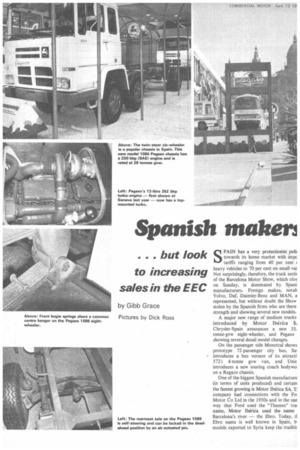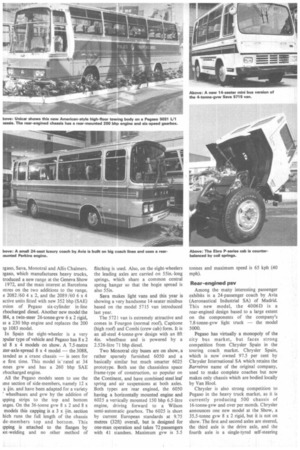Spanish makers dominate Barcelona Show
Page 50

Page 51

Page 53

Page 54

If you've noticed an error in this article please click here to report it so we can fix it.
but look to increasing sales in the EEC
by Gibb Grace
Pictures by Dick Ross
SPAIN has a very protectionist poli4 towards its home market with impc tariffs ranging from 40 per cent c heavy vehicles to 70 per cent on small var Not surprisingly, therefore, the truck sectic of the Barcelona Motor Show, which clos on Sunday, is dominated by Sparti manufacturers_ Foreign makes, notab Volvo, Daft Daimler-Benz and MAN, a represented, but without doubt the Show stolen by the Spanish firms who are there strength and showing several new models.
A major new range of medium trucks introduced by Motor Ibiriea S, Chrysler-Spain announces a new 35. tonne-gvw eight-wheeler, and Pegaso showing several detail model changes.
On the passenger side Monotral shows prototype 72-passenger city bus, Sal introduces a bus version of its attractir 5721 4-tonne gvw van, and Unic introduces a new touring coach bodywo. on a Regazo chassis.
One of the biggest Spanish manufacture (in terms of units produced) and certain the fastest growing is Motor Iberica SA. T1 company had connections with the Fo: Motor Co Ltd in the 1950s and in the san way that Ford used the "Thames" tra4 name, Motor IberiCa used the name Barcelona's river — the Ebro, Today, ti Ebro name is well known in Spain, b. models exported to Syria keep the traditic
dive by being named Frat after that :ountry's river — the Euphrates!
Mew Ebro range
Motor Iberica has used the Show to =ounce a new Ebro range — the P cries. Three models have been announced — P-112, P-137 and P-170; the designation .eflects gross vehicle weight, ie the P112 is 11.2-tonne-gvw design. Previously, the aeaviest Ebro model was 10 tonnes gvw ind the introduction of the P series is in line with Motor Iberica's intention of moving up he weight range eventually to the top weight.
The new models are in no way beefed-up versions of what has gone before, but are tew designs from the ground up, developed a cost of some £15m.
Perkins-Spain is a wholly owned nibsidiary of Motor Theriaa SA and thus it s not surprising to find that Ebro vehicles ase Perkins engines. Models P112 and P-137 use the 6.354 engine and P-170 the V8-540 — a derivative of the V8-510 which s not yet available in the UK. Neither of hese engines is made in Spain as yet, but ire imported from Britain.
The 6.354 engine drives through a 280 lb I five-speed American Clark gearbox, the V8-540 is used in conjunction with a similar nit larger 380 lb ft model. The clutch is massisted but its travel is short and its operating load light. Rear axles are standard Eaton designs, built under licence in Pamplona; the P-170 uses a two-speed 16000 model rated at 11 tonnes. Front axles are fitted with dampers and the P-170 has power steering as standard. Front springs are conventional, but rear springs are a dual-rate slipper-ended type. The spring pack and axle are located fore and aft by a trailing half leaf anchored to the leading spring hanger. On the P-170 the main spring pack consists of relatively few thick leaves in order to give low friction and is 1.80m (5ft 1 lin.) long to give good ride. The P-170 has a full air braking system with wedge-operated twin-leading shoes on both axles. Front and rear brake linings are 7 and 8in, wide respectively. Parking is by spring brake units and as they are' controlled by a remote relay valve, the parking brake lever in the cab is light to operate and unobtrusive. Standard-type equipment is 12-22.5 tubeless.
Cab interest Today much of the interest of a new vehicle is in the cab and the P series has a completely new pressed-steel cab which is factory painted By current standards the cab is on the small side, and headroom is insufficient for the taller driver, but otherwise the cab is well laid out and compares favourably with British cabs. The driving position is particularly good with the steering wheel and pedals positioned in line with the seat. Instrumentation looks good, is clear to read and is mounted on fold-down panels for easy maintenance. Fuses are easily accessible on a printed-circuit board under a cover on the dash. The standard cab is well trimmed, but the de luxe cab has a carpet, full-depth door trims and an American-style wrap-round instrument panel. The de Kum cab is a separate exhibit and not mounted on chassis and looks like a mock-up but I was assured that this advanced style of dash layout is fay developed and is currently available.
The cab tilts and is counterbalanced by an unusual coil-spring arrangement. Two coil springs are used and are so designed that they are compressed with the cab down and under tension with the cab up, and thus assist tilting in the fully up and down position. Some clever detail design has enabled the steering column and the throttle hinge points to coincide with the cab hinge line.
Motor Iberica's 36-year-old managing director, Pedro Olobarrio, told me that the P series had been developed to compete with EEC-built vehicles, in the anticipation of growing sales outside Spain.
Spain's biggest vehicle manufacturer is ENASA (Empress Nacional de Autocamiones SA) which is a conglomerate of !gas°, Sava, Monotral and Allis Chalmers. !gaso, which manufactures heavy trucks, troduced a new range at the Geneva Show 1972, and the main interest at Barcelona :ntres on the two additions to the range, e 2082 /60 4 x 2, and the 2089/60 6 x 4 active units fitted with new 352 bhp (SAE) ;rsion of Pegaso six-cylinder in-line rbocharged diesel. Mother new model the )84, a twin-steer 26-tonne-gvw 6 x 2 rigid, is a 230 bhp engine and replaces the 200 ip 1083 model.
In Spain the eight-wheeler is a very vular type of vehicle and Pegaso has 8 x 2 xi 8 x 4 models on show. A 7.5-metre ger-axle-spread 8 x 4 model — the 3088, tended as a crane chassis — is seen for Le first time. This model is rated at 34 :nnes gvw and has a 260 bhp SAE rbocharged engine.
All the Pegaso models seem to use the Lme section of side-members, namely 12 x x fin. and have been adapted for a variety ' wheelbases and gvw by the addition of ipping strips to the top and bottom Inges. On the 36-tonne gvw 8 x 2 and 8 x models this capping is a 3 x fin. section hich runs the full length of the chassis de-members top and bottom. This 'ming is attached to the flanges by oot-welding and no other method of flitching is used. Also, on the eight-wheelers the leading axles are carried on 55in.-long springs, which share a common central spring hanger so that the bogie spread is also 55in.
Sava makes light vans and this year is showing a very handsome I4-seater minibus based on the model 5715 van introduced last year.
The 5721 van is extremely attractive and comes in Fourgon (normal roof), Capitone (high roof) and Combi (crew cab) form. It is an all-steel 4-tonne-gvw design with an 8ft 4m. wheelbase and is powered by a 2.526-litre 71 bhp diesel.
Two Monotral city buses are on show, a rather sparsely furnished 6050 and a basically similar but much smarter 6025 prototype. Both use the chassisless space frame-type of construction, so popular on the Continent, and have combined steel leaf spring and air suspensions at both axles. Both types are rear engined, the 6050 having a horizontally mounted engine and 6025 a vertically mounted 150 bhp 6.5-litre engine, driving forward to a Wilson semi-automatic gearbox. The 6025 is short by current European standards at 9.75 metres (32ft) overall, but is designed for one-man operation and takes 72 passengers with 41 standees. Maximum gvw is 5.5 tonnes and maximum speed is 65 kph (40 mph).
Rear-engined pew
Among the many interesting passenger exhibits is a 24-passenger coach by Aria (Aeronautical Industrial SA) of Madrid. This new model, the 4006D is a rear-engined design based to a large extent on the components of the company's 7.8-tonne-gvw light truck — the model 5000.
Pegaso has virtually a monopoly of the city bus market, but faces strong competition from Chrysler Spain in the touring coach market. Chrysler Spain, which is now owned 97.5 per cent by Chrysler International SA which retains the Barreiros name of the original company, used to make complete coaches but now makes only chassis which are bodied locally by Van Hool.
Chrysler is also strong competition to Pegaso in the heavy truck market, as it is currently producing 500 chassis of 16-tonne-gvw and over per month. Chrysler announces one new model at the Show, a 35.5-tonne gvw 8 x 2 rigid, but it is not on show. The first and second axles are steered, the third axle is the drive axle, and the fourth axle is a single-tyred self-steering axle. The single-tyred axles are rated at tonnes and the drive axle at 13 tontu giving a total of 37 tonnes and allowir some loading tolerance.
Body and payload allowance is nearly 2 tonnes. This model uses Chrysler's mo powerful engine, the 275 bhp turbocharge inter-cooled BS 36. At the Show this engir is featured in the Barreiros 42 /38 38-tonne-gcw tractive unit.
Trailers and bodywork
Apart from the trucks and buses there i also a good exhibition of trailers an bodywork. The rigid is by far the ma popular vehicle in Spain, with the arti catching on quickly — but drawbar unii are hardly ever used. Daf make semi-trailers in Spain, and has steel an aluminium 38-tonne-gcw tipping designs o show. The Spanish company, Industril Acerbi SA, is showing an unusui underbody-mounted gear on a tippin semi-trailer.
No British manufacturers are represente at the Show; Daimler-Benz has introduce its heavy range of vehicles to Spain, but th other foreign manufacturers present at showing established models.
























































































































